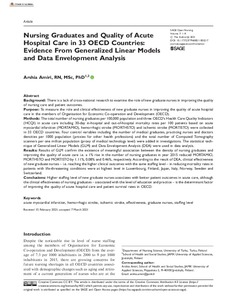Nursing graduates and quality of acute hospital care in 33 OECD countries: Evidence from Generalized Linear Models and Data Envelopment Analysis
Amiri Arshia
https://urn.fi/URN:NBN:fi-fe2021042826387
Tiivistelmä
Background
There is a lack of cross-national research to examine the role of new graduate nurses in improving the quality of nursing care and patient outcomes.
Purpose
To measure the role and clinical effectiveness of new graduate nurses in improving the quality of acute hospital care in the members of Organisation for Economic Co-operation and Development (OECD).
Methods
The total number of nursing graduates per 100,000 population and three OECD’s Health Care Quality Indicators (HCQI) in acute care including 30-day in-hospital and out-of-hospital mortality rates per 100 patients based on acute myocardial infarction (MORTAMIO), hemorrhagic stroke (MORTHSTO) and ischemic stroke (MORTISTO) were collected in 33 OECD countries. Four control variables including the number of medical graduates, practicing nurses and doctors densities per 1000 population (proxies for other health professions) and the total number of Computed Tomography scanners per one million population (proxy of medical technology level) were added in investigations. The statistical technique of Generalized Linear Models (GLM) and Data Envelopment Analysis (DEA) were used in data analysis.
Results
Results of GLM confirm the existence of meaningful association between the density of nursing graduates and improving the quality of acute care i.e. a 1% rise in the number of nursing graduates in year 2015 reduced MORTAMIO, MORTHSTO and MORTISTO by 1.11%, 0.08% and 0.46%, respectively. According to the result of DEA, clinical effectiveness of new graduate nurses – i.e. reaching the higher clinical outcomes with the same staffing level – in reducing mortality rates in patients with life-threatening conditions were at highest level in Luxembourg, Finland, Japan, Italy, Norway, Sweden and Switzerland.
Conclusions
Higher staffing level of new graduate nurses associates with better patient outcomes in acute care, although the clinical effectiveness of nursing graduates – associated with the level of education and practice – is the determinant factor of improving the quality of acute hospital care and patient survival rates in OECD.
Kokoelmat
- Rinnakkaistallenteet [19207]
